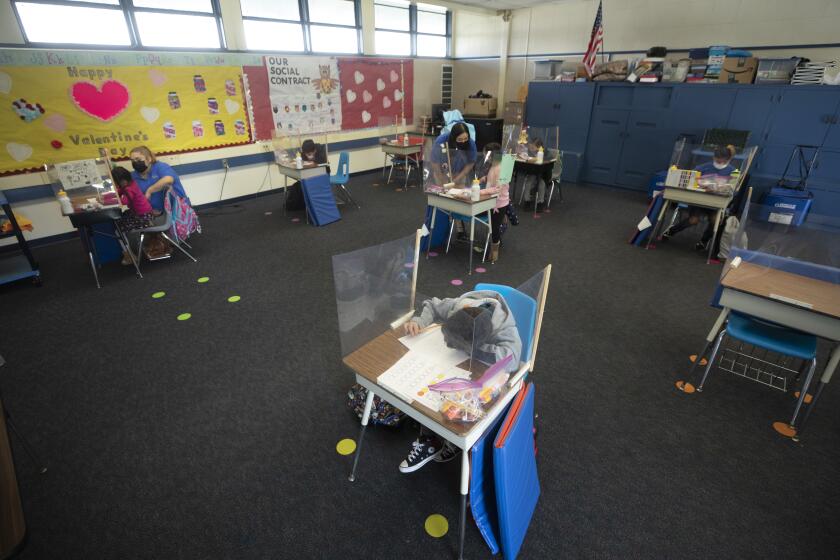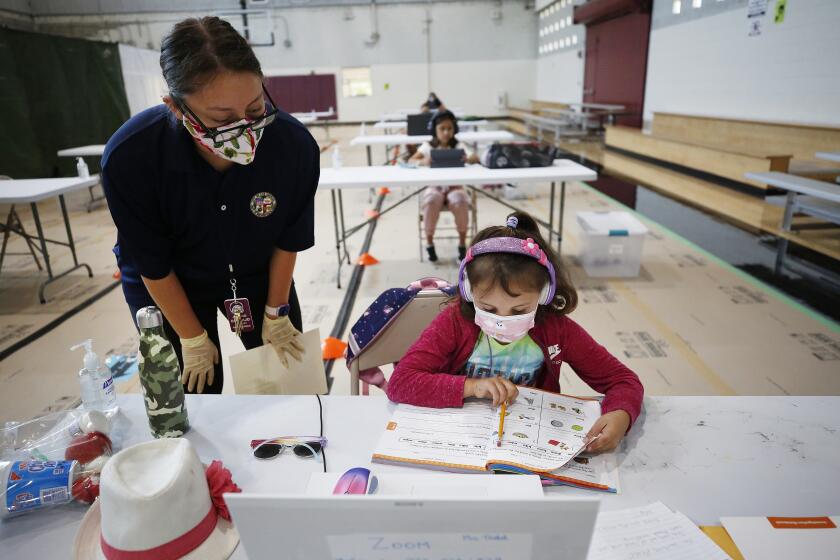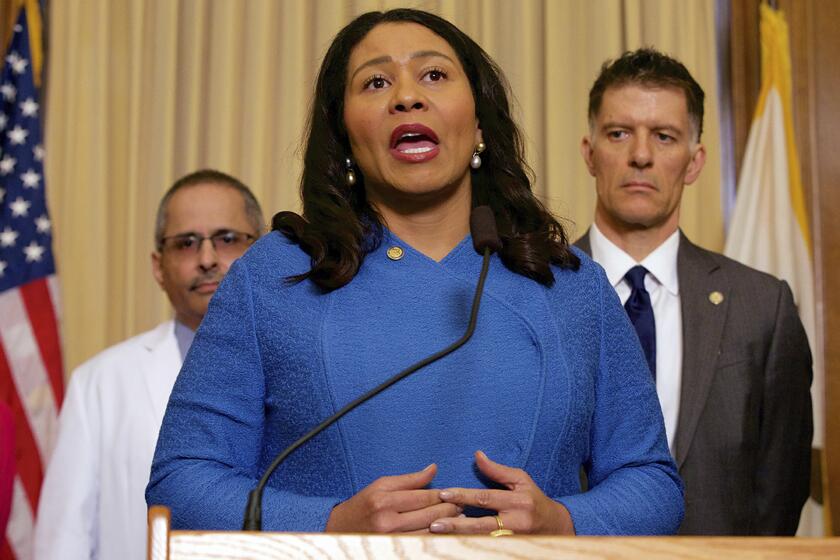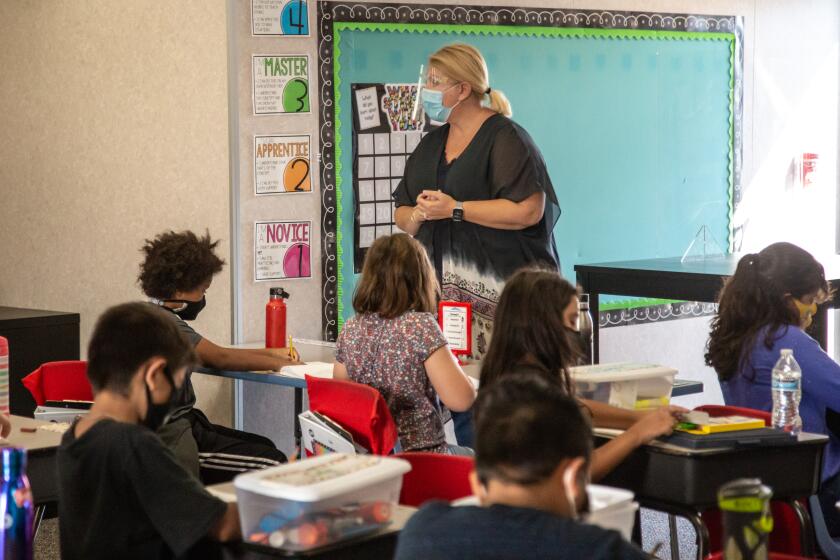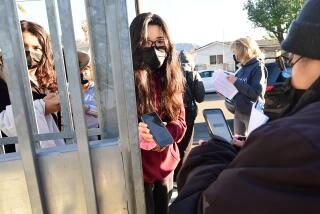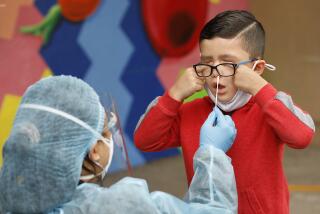Teachers face pressure to return even before COVID-19 vaccinations completed
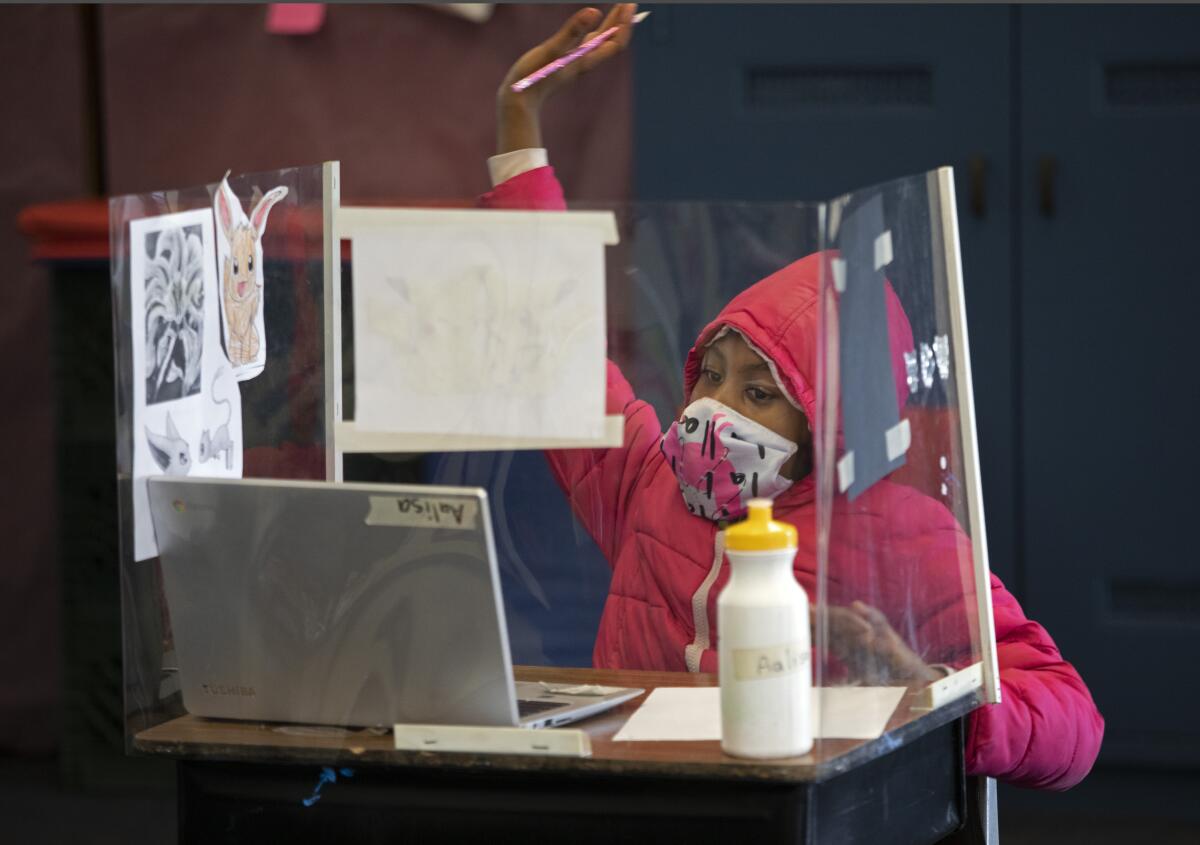
- Share via
The battle over reopening California schools intensified Wednesday when Gov. Gavin Newsom and the Biden administration said campuses can safely reopen without teachers being vaccinated — and unions pushed back, calling for school workers to be immunized as part of any sweeping reopening effort to return students to classrooms.
Echoing the debate, the Southern California chapter of the American Academy of Pediatrics called for schools to open immediately, asserting that the harms of keeping children out of school outweigh the risks of reopening. Meanwhile, United Teachers Los Angeles accused officials of playing politics with the lives of its members, students and their families.
The ferment over reopening has become more urgent in the state’s counties as coronavirus infection rates and other health metrics trend in a positive direction — which could soon allow for the reopening of campuses that have been closed since last March in Los Angeles, Orange and San Diego counties, among others. Already, 18 counties outside of Southern California are permitted to open elementary campuses under recently adopted state guidelines.
State and federal officials have insisted for some time that campuses for kindergarten through 12th grade students can reopen safely without teachers being vaccinated — and they reiterated that point Wednesday.
“There is increasing data to suggest that schools can safely reopen, and that safe reopening does not suggest that teachers need to be vaccinated, ” Dr. Rochelle Walensky, the new director of the U.S. Centers for Disease Control and Prevention, said at a briefing of the White House COVID-19 response team.
When asked about the CDC director’s comments, Newsom said he subscribes “to the Biden administration’s point of view, reinforced again today in their press conference, that we can safely reopen schools with [an] appropriate level of support.”
The governor was more blunt in an online symposium last week of the Assn. of California School Administrators. He said that if vaccinations for all school workers were a precondition for returning to classrooms this academic year, “we might as well just tell people the truth: There will be no in-person instruction in the state of California. Just tell them the truth.”
On Wednesday, Newsom insisted that he has done his part by prioritizing teachers — placing them in an upper tier of eligibility for vaccines.
However, under state rules, it’s up to local health authorities to decide whether teachers and other school workers have access to vaccines now or later — when supplies become more abundant.
Gov. Gavin Newsom said he believes California’s educators can return to their classrooms provided proper safety measures and supports are in place
In L.A. County, higher-priority groups, including healthcare workers and those 65 and older, are eligible for vaccines, whereas teachers are not. In Long Beach, which has its own health department, school district employees are eligible for immunizations, although they face the same challenges scheduling appointments as others.
A spokesperson for the California Teachers Assn. praised the intent of the Biden administration to open schools safely and the CDC’s efforts to “make up for lost time” in the wake of the Trump administration.
The union said that the state should prioritize school employees in order of greatest need to open campuses in phases — and also to protect employees in campuses already open.
“They should get vaccines to all employees required to report in-person and before the students return to campus,” said Claudia Briggs.
The harms of ongoing closures outweigh the safety risks of carefully managed classrooms, according to a regional pediatrics association. Some experts take a different view.
Los Angeles Unified Supt. Austin Beutner has said it’s crucial that health officials target school employees for vaccination while campuses are closed so that this impediment to reopening is removed.
“It won’t be sufficient to vaccinate some school staff now and others far down the road,” Beutner added.
Campuses in the nation’s second-largest school district have been prepped to operate safely for instruction and to serve as community immunization centers, he said.
Because of complex and evolving guidelines — and health conditions — some suburban and rural California school districts have reopened. Others successfully applied for elementary school waivers to reopen or took advantage of rules allowing in-person services for students with special needs.
The reluctance of some districts to reopen, including L.A. Unified, has prompted litigation. In San Francisco on Wednesday, city officials took the unusual step of suing their own school system for not ramping up in-person services.
San Francisco, frustrated that K-12 classes remain closed as education leaders rename schools, sued the district Wednesday to force a reopening.
Teachers in other parts of the country have embraced or acquiesced to a return to in-person instruction — without vaccines — although the issue remains in play in some regions where infections have spiked.
Chicago teachers have threatened to strike over a back-to-campus order that was put on hold at the last minute as negotiations continue over making campuses safer. In New York City, which has lower case rates than L.A., the school system opened 1,052 schools in December, the vast majority for younger students, and has been plagued with frequent shutdowns because of outbreaks.
In another union pushback, the two statewide teachers unions — CTA and the California Federation of Teachers — have opposed all in-person instruction in counties that are in the worst tier for coronavirus spread. That tier is coded with the color purple — and 54 of 58 counties fall into that level, encompassing all major population centers.
The state’s recently revised rules allow for elementary campuses to reopen when the seven-day average of daily cases is 25 or fewer per 100,000 people. That’s nearly four times greater than the levels it would take to exit the purple tier, which until last month had been the governor’s standard.
Governor Gavin Newsom on Thursday announced some changes to his plan to reopen schools, which includes a small decrease in the case rate that would allow for campuses to open.
Newsom points to what he sees as a building body of studies to justify the relaxed standard.
Dr. Eric Toner, a senior scholar with the Johns Hopkins Center for Health Security, said increasing evidence suggests that elementary-age children don’t transmit the virus as much as adults, and that the virus doesn’t make them as sick.
“I don’t fault anybody for imposing the school closures,” he said. “The consensus now is that reopening schools does make sense.”
One widely cited study looked at 11 North Carolina school districts with a total of 100,000 students and staff. In the first nine weeks of the 2020-21 school year, researchers recorded 773 coronavirus infections among teachers, students and staff. Of these, 32 infections appeared to originate at school, according to a report in the journal Pediatrics.
Researchers found no cases of students transmitting the virus to adults. When transmission did occur, it was mostly related to poor adherence to masking rules, including one cluster linked to children eating together, the study authors wrote.
Masks were part of extensive safety measures that included having students attend in-person classes part-time in small groups on a staggered schedule, along with screening for symptoms, maintaining physical distancing between students and enhanced cleaning and handwashing.
At the time of the study, all of the counties with participating schools were recording about 14 to 28 new infections per 100,000 residents per day. Current infection rates are higher both in Southern California and in North Carolina, where the schools that were studied remain open.
Outbreaks can occur even when schools have extensive mitigation strategies in place, including masking, distancing, air filtration and coronavirus testing, said Michael Lachmann, an evolutionary biologist at the Santa Fe Institute.
However, his research suggests that outbreaks can be quickly contained. In one study, fewer than 10% of infected people spread the virus to anyone else, and when that did happen, it spread to about five others.
“With all mitigation measures, the virus spreads in school, but not uncontrollably,” he said. “Each outbreak stops on its own, or due to testing” for the infection.
The case for reopening schools immediately is not as clear-cut as some want it to be, said Theresa Chapple-McGruder, an epidemiologist in the Washington, D.C., area who specializes in maternal and child health and has advised 27 school districts on their reopening plans.
“There are a lot of holes in the data,” Chapple-McGruder said. “We don’t have good rates of children being tested. And we know that children are more likely to be asymptomatic” when infected.
She added that it’s important to remember that “children live within families,” and the disease spreads easily within households.
“We need to be limiting our exposure to the virus, either through schooling at home, working from home — any ways that we can try and manage to stay safe at home — is really the same message that needs to be out today as it was six months ago, when the virus was not at such high peaks as it is today,” she said. “We need to be focused on those same prevention strategies that we used then.”
Leaders of Southern California Chapter 2 of the American Academy of Pediatrics said Wednesday that they’ve seen more than enough evidence to call for an immediate return to in-person services. This group, which represents 1,500 professionals in a seven-county Southern California region, advocated as early as June for a return to campus.
The death toll among Los Angeles County’s Latino residents is nearly triple that of white residents, data show.
The union that represents L.A. teachers, librarians, nurses and counselors said the pediatricians understated researchers’ warnings that preventing transmission in schools requires reducing levels of infection in the community.
“Saying the temporary trauma from distance learning is greater than illness and death of family members conveniently minimizes the reality that COVID-19 disproportionately impacts” families of color in Los Angeles, said Cecily Myart-Cruz, president of United Teachers Los Angeles. “Although, thankfully, serious illness and death among children is rare, 78% of the children who have died in the U.S. are children of color.”
Myart-Cruz also had strong words for officials pushing for a rapid return.
“If this disease was disproportionately killing white children, parents and grandparents, the response to COVID-19 from our politicians would have looked very different,” she said.
The union and school officials are currently negotiating what a return to campus would look like.
Times staff writers Taryn Luna and Melissa Gomez contributed to this report.
More to Read
Sign up for Essential California
The most important California stories and recommendations in your inbox every morning.
You may occasionally receive promotional content from the Los Angeles Times.
